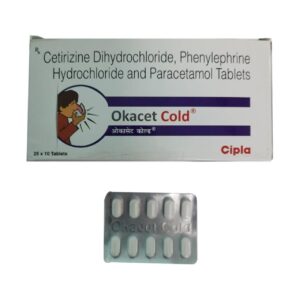PARACETAMOL (ACETAMENOPHEN) + CETIRIZINE + PHENYLEPHRINE
Paracetamol (acetamenophen): Paracetamol, also known as acetaminophen, is a widely used over-the-counter medication that acts as a pain reliever and fever reducer. It is commonly used to alleviate mild to moderate pain and to reduce fever. Paracetamol is available in various forms, including tablets, capsules, liquid suspension, and suppositories.
The exact mechanism of action of paracetamol is not fully understood. It is believed to work by inhibiting the production of prostaglandins in the brain. Prostaglandins are chemicals released in response to injury or illness and are responsible for causing pain and fever. By suppressing their synthesis, paracetamol helps to reduce pain and fever symptoms.
The recommended dose of paracetamol for adults is typically 500 to 1000 mg every 4 to 6 hours, with a maximum daily dose of 4000 mg. It is important to follow the dosage instructions and not exceed the recommended amount, as excessive use can lead to liver damage.
While paracetamol is generally considered safe when used as directed, it can cause side effects in some individuals. Common side effects include nausea, vomiting, stomach pain, and rash. Rarely, it can cause a serious allergic reaction, such as difficulty breathing or swelling of the face, lips, tongue, or throat. If any severe side effects occur, medical attention should be sought immediately.
It is important to note that paracetamol should not be used by individuals who have a history of liver disease or excessive alcohol consumption, as it can cause further liver damage. Additionally, it is essential to check for any drug interactions with other medications, especially those that can also affect liver function.
Overall, paracetamol is a widely used and effective medication for relieving pain and reducing fever. However, it is always recommended to consult with a healthcare professional before starting any new medication, especially if you have any existing medical conditions or are taking other medications.
Cetirizine: Cetirizine is an antihistamine drug used primarily to relieve the symptoms of allergies such as hay fever, allergic rhinitis, and hives. It is available over-the-counter and by prescription in various forms including tablets, oral solution, and chewable tablets.
The mechanism of action of cetirizine involves blocking the effects of histamine, which is a natural chemical released in the body during an allergic reaction. Histamine is responsible for triggering symptoms like itching, sneezing, runny nose, and watery eyes. By blocking histamine receptors, cetirizine helps to reduce these allergy symptoms.
The recommended dosage of cetirizine for adults and children 6 years and older is typically 10 mg once daily, while for children aged 2 to 5 years, the recommended dose is 5 mg once daily. However, it is always advisable to follow the specific dosing instructions provided by the doctor or found in the package insert.
Common side effects of cetirizine may include drowsiness, dry mouth, headache, fatigue, and stomach upset. While drowsiness can occur with cetirizine, it is generally less sedating compared to older antihistamines. It is important to note that cetirizine may interact with other medications, so it is essential to consult with a healthcare professional before starting it, especially if you have any underlying medical conditions or take other medications.
Overall, cetirizine is a widely used antihistamine that effectively provides relief from allergy symptoms. However, it is always recommended to consult a healthcare professional for proper diagnosis, dosage, and management of allergies or allergic conditions.
Phenylephrine: Phenylephrine is a medication commonly used as a nasal decongestant and in some over-the-counter cold and sinus medications. It is also used as a mydriatic agent to dilate the pupil during certain eye examinations or procedures.
The primary mechanism of action of phenylephrine is as an alpha-1 adrenergic agonist. This means that it stimulates alpha-1 receptors in blood vessels, causing vasoconstriction (narrowing of the blood vessels) and reducing swelling and congestion in nasal tissues. In the eyes, it acts on the dilator muscles of the iris, causing dilation of the pupil.
The typical dose of phenylephrine varies depending on the form of the medication and the condition being treated. For nasal congestion, the usual nasal spray concentration is 0.25-1% phenylephrine hydrochloride, and the recommended dose is usually 2-3 sprays in each nostril every 4 hours. For eye dilation, a 2.5% or 10% solution of phenylephrine hydrochloride is commonly used, with one or two drops being instilled into the eye as needed.
Common side effects of phenylephrine include increased blood pressure, headache, dizziness, nervousness, and restlessness. Some individuals may also experience difficulty sleeping, increased heart rate, or nausea. In the eyes, phenylephrine can sometimes cause temporary blurred vision or increased sensitivity to light. These side effects are usually mild and resolve on their own.
It is important to note that phenylephrine should be used with caution in individuals with conditions such as high blood pressure, heart disease, or thyroid problems. It is always advisable to consult a healthcare professional or read the package insert for specific dosing instructions and to understand potential drug interactions or contraindications before using phenylephrine.


